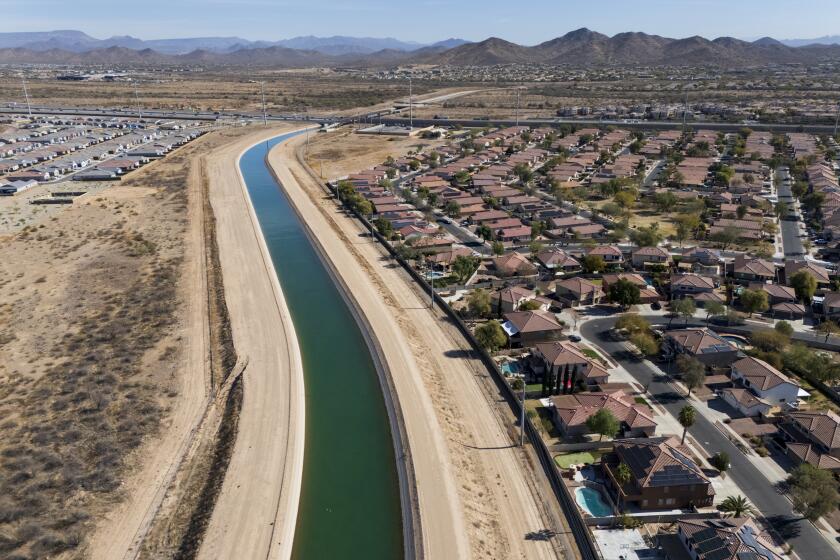The Colorado River’s massive reservoirs are now so depleted that another dry year could send them plunging to dangerously low levels, a group of prominent scholars warns in a new analysis.
The researchers are urging the Trump administration to intervene and impose substantial cutbacks in water use across the seven states that rely on the river — California, Arizona, Nevada, New Mexico, Colorado, Utah and Wyoming.
“We’ve got a real problem, and we ought to deal with it sooner rather than later,” said Jack Schmidt, director of Utah State University’s Center for Colorado River Studies, who co-authored the analysis. “Everybody needs to be looking at ways to cut right now.”
The Colorado River provides water for cities from Denver to San Diego, 30 Native tribes and farming communities from the Rocky Mountains to northern Mexico.
The river has long been overused, and its reservoirs have declined dramatically amid persistent dry conditions since 2000. Research has shown that the warming climate, driven largely by the use of fossil fuels, has intensified the long stretch of mostly dry years.
Read more: Groundwater is rapidly declining in the Colorado River Basin, satellite data show
A meager snowpack in the Rocky Mountains last winter added to the strains on the river. The researchers analyzed the latest federal data and found that if the coming winter is just as dry, the river’s major reservoirs would approach critically low levels unless there are major reductions in water usage.
“The results are grim,” the experts wrote in the report, which was released Thursday. If next year turns out to be a repeat of this year, they wrote, total water use would exceed the river’s natural flow by at least 3.6 million acre feet — nearly as much as California used in all last year.
Under such a scenario, the region’s water use would again exceed the river’s flow by more than one-fourth.
The researchers said a snowy winter could always bring some relief. But they noted that the federal government’s latest seasonal forecast says the Southwest will probably have above-average temperatures and below-average precipitation over the next several months.
They called for the Interior Department, which oversees the dams and management of the river, to “take immediate action.”
“Avoiding this possible outcome requires immediate and substantial reductions,” the researchers wrote. “Taking steps now to decrease consumptive uses across the Basin will reduce the need to implement draconian measures in the following years.”
A tour boat cruises on Lake Powell in Glen Canyon National Recreation Area near Page, Ariz. The reservoir on the Colorado River has declined in recent years and is at less than one-third of its capacity. (Rebecca Noble / Getty Images)
Near Las Vegas, Lake Mead, the nation’s largest reservoir, is now just 31% full.
Upstream from the Grand Canyon, Lake Powell, the country’s second-largest reservoir, is at 29% of capacity.
Federal officials have said they want to keep Lake Powell well above a point where water could pass downstream only through Glen Canyon Dam’s low-level bypass tubes.
Officials say those four 8-foot-wide steel tubes could create a bottleneck that limits how much water makes it to California, Arizona, Nevada and Mexico. Last year, federal officials discovered damage inside the tubes that could further restrict water flow when reservoir levels are low.
The researchers carried out their analysis looking at what they called “realistically accessible water” in Lake Mead and Lake Powell — using critical thresholds established by federal managers.
“A near term crisis is unfolding before our eyes,” the researchers wrote in a blog post announcing the report. “The gap between ongoing water use and the reality of how much water actually flows in the Colorado River poses a serious near term threat.”
Read more: Hay grown for cattle consumes nearly half the water drawn from Colorado River, study finds
After a series of dry years, heavy snowpack in the Rocky Mountains in 2023 brought some relief to the depleted reservoirs. That was followed by near-average river flow in 2024 compared with the last quarter-century. But this year, the snowmelt runoff in the river’s upper basin was only about 70% of the average.
Representatives of the seven states have been holding difficult negotiations to develop new rules for dealing with shortages after 2026, when the current rules expire.
While those negotiations continue, Schmidt and the other researchers said the situation calls for immediate action to reduce demands on the river.
“We think that [the Bureau of] Reclamation needs to address all this right now and begin to implement cuts,” Schmidt said, adding that the reductions should be shared among all seven states.
Read more: Humanity is rapidly depleting water and much of the world is getting drier
Alyse Sharpe, a spokesperson for the Interior Department, said the Bureau of Reclamation is closely monitoring conditions, and as the expiration of the current rules approaches, “we are actively engaging with our partners across the Colorado River Basin to develop new long-term operational agreements.”
“This is a moment that demands urgency, collaboration and transparency,” Sharpe said in an email. “We remain committed to working with Basin states, tribes, Mexico and stakeholders to ensure a sustainable and resilient future for the Colorado River system.”
In recent years, the seven states have adopted a series of incremental water-saving plans to try to prevent the reservoirs from reaching perilously low levels.
As part of those agreements, farmers in California’s Imperial Valley have been voluntarily leaving some hay fields dry and unplanted part of the time in exchange for payments through programs that received federal funding during the Biden administration.
Experts said they are unsure if the Trump administration will make more funding available for those types of water-saving efforts.
Read more: They sounded alarms about a coming Colorado River crisis. But warnings went unheeded
Anne Castle, a senior fellow at the University of Colorado Law School’s Getches-Wilkinson Center who co-authored the report, said it is intended as a “wake-up call” to water managers throughout the Colorado River Basin.
The reductions in water use will be politically difficult, Castle said, but she noted that the seven states have a history “with prodding from the federal government, to ultimately come to agreement around solutions.”
The focus, Castle said, should be “on this short-term management issue so that we don’t find ourselves in a deeper hole.”
This story originally appeared in Los Angeles Times.









